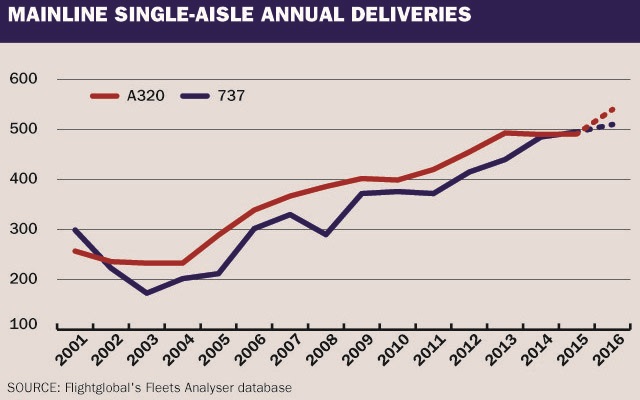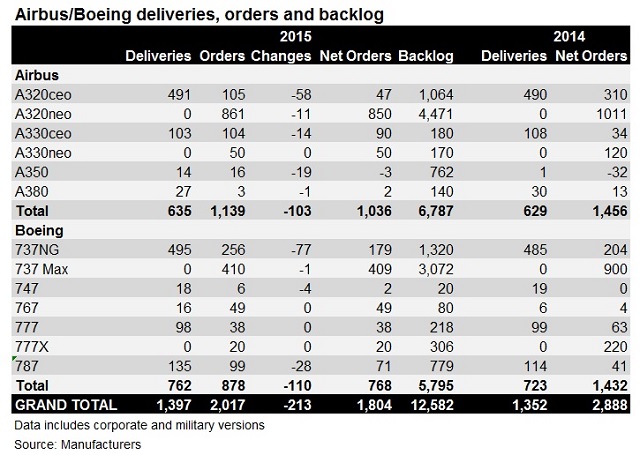Boeing's 737 stole the single-aisle output crown from Airbus last year after a hiatus of more than a decade. But it is likely to be a briefly held lead, with the European manufacturer moving back ahead as it ramps up output this year.
The 737's overtake of the Airbus A320 family came as the gulf in overall output between the two rivals widened in 2015. Boeing delivered 762 aircraft, a 5% rise on its 2014 tally, while Airbus production was essentially flat – increasing from 629 units to 635. Both totals were personal bests, with Boeing breaking the industry record of 723 deliveries it set in 2014. Their combined production increased just over 3% to almost 1,400 aircraft.
While Seattle raised full-year 737 output by 10 units to 495 aircraft, production of the A320 was flat at 491 aircraft. This gave the Boeing twinjet its first production victory over the A320 since 2001 – when 299 737s were delivered, versus 257 A320s. The following year both manufacturers cut output in the wake of the 9/11 terrorist attacks. While Airbus resisted pressure to slash A320 deliveries, shipping 236 aircraft, Boeing dropped the 737 rate by a quarter to 223 aircraft.

Since 2002, Airbus has maintained a lead over its rival which grew to almost 100 units in 2008 – 386 A320s versus 290 737s – before the delta began to reduce to the point where Boeing moved in front last year.
However, Chris Seymour – head of market analysis at Flightglobal's Ascend consultancy – expects Boeing's success last year to be a blip and that Airbus will retake the single-aisle crown in 2016.
"As the A320neo enters the fray, Airbus will ramp up production faster than Boeing this year and move ahead again, to reach 50 a month by Q1 2017. The 737 will reach 47 a month in 2017 as the Max enters service," says Seymour.
This year, combined output of the A320 and 737 is forecast to rise 6% to approximately 1,050 deliveries, effectively double their tally in 2001. Seymour says that by 2020 the two manufacturers will be building over 1,300 single-aisles a year, with Airbus output at 60 units a month and Boeing at 52.
In overall terms, Boeing's share of mainline jet deliveries increased to almost 55% last year, from 53% in 2014. This marks the fourth successive year that the Seattle manufacturer has out-produced Airbus, a trend that looks set to continue in the near term.
"Boeing's ongoing lead reflects the strength of its widebody output with 233 777s and 787s delivering in 2015, compared with just 117 A330s and A350s," says Seymour. "The A350 will see a significant increase in production during 2016, but won't reach its full 10 a month rate until 2018."
Seymour envisages Boeing maintaining its output advantage for at least another two years but highlights industry speculation that the 777 rate may need to be cut by 2017 as the manufacturer "bridges" production to the 777X.
"Even with the A330 rate coming down, the gap between the two OEMs is expected to narrow," he says.

From an orders perspective, Airbus and Boeing's combined tally declined more than a third last year from the all-time commercial jet record of 2,888 net orders in 2014, to 1,804 net sales. While this is still a respectable tally, it is the first time that combined net orders has dropped below the 2,000-mark since 2010.
Airbus was top seller for a third consecutive year, securing 1,036 net orders compared with its rival's total of 768. The success of its A320 powered much of Airbus's advantage, with net sales for all variants reaching 897 last year, compared with 588 737NG/Max aircraft.
With Boeing achieving a book-to-bill ratio of one and Airbus reaching 1.6, the combined order backlog grew during 2015 by over 3% to almost 12,600 aircraft. This represents around seven years of production at currently planned rates.
Source: Cirium Dashboard























